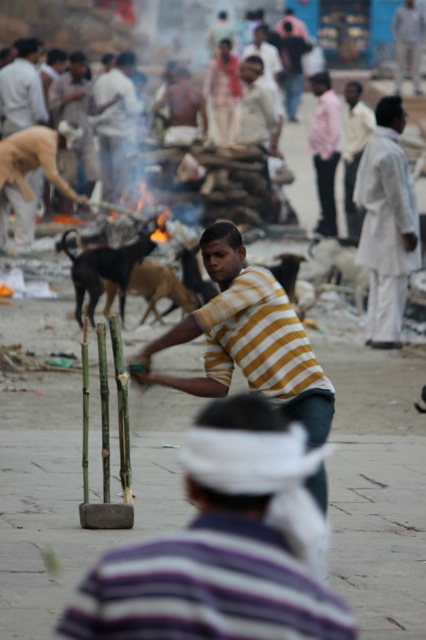Varanasi is bursting with life, death and decay. Being here is like finding oneself in a post-apocalyptic, Mad Max film. This city is said to be the most “holy” in India and is over 3,000 years old.
It contains an inescapable intensity. The city wakes at 5 a.m. and all along the ghats (way down to the water) people greet the day with ritual, fire, bells, offerings to the great Mother Ganga, cremating the dead or lighting candles for loved ones. Others are bathing in the river with water buffalo or urinating against the ancient walls.
To a back drop of flute and chanting we enter a boat on the river at 6 a.m. and float past all the activity at the river’s edge. A large piece of graffiti that says, “Good morning, Varanasi!,” adorns one of the temple walls. Market boats come selling cheap and colourful bangles and snacks. We set the memories of our loved ones alight on tiny candles and let them go, adrift with the current.
Coming to the main cremation ghat where Hindus bring their dead to burn and pass their ashes into the Ganges we see piles of wood and smoke rising. It is auspicious to die or be cremated in Varanasi. One has a great chance of entering a heavenly realm if his or her remains go into the water. The poor are burned using second-hand charred wood; the remains of the wealthy dead. The bodies of pregnant women, children, lepers or those bitten by cobras are, on the other hand, dropped into the river intact and weighted. Everything goes into the Ganges.
It is fitting that we are here to witness this after being in Kushinagar where the Buddha died. In Varanasi all aspects of life and death are in full view and if we didn’t catch the theme of impermanence in Kushinagar while listening to Mr. Feldman read about the Buddha’s sickness and passing, it’s impossible to miss it here. We watch the bodies burning. Dogs are poking in the ashes, children play,people watch. I see a tibia and a black foot curling. Unlike the West where sickness and death are often hidden or sanitized, here it is all part of existence. We live. We die.
Varanasi provides ample opportunity to get curious about our reactions and the feeling tones that come and go with each situation that confronts us. We are learning to inquire into these experiences. Sometimes it is easier to investigate our reactions in difficult situations–and India is nothing if not difficult. Why do this? Investigation can help us notice habitual reactions before they take hold, can allow us to be awake to what grabs or repels and see how we manage when we are wanting, averse to, or not attending to the moments that make up our lives. We can also see how strongly we are attached to our ideas about things or who we believe ourselves to be.
When we see a body burning, it is just that. It is only flesh, bone and sinew. One day that will be us. Seeing this can help us bring that “investigative curiosity” to our lives and by waking up to the impermanence of all things we can loosen from our self-importance and the suffering that it ultimately brings. When does a body stop being a body? Where is the self? Varanasi bombards you with impermanence. You have to decide how much of it you can or are willing to internalize and how much to leave behind.
In Varanasi, everything is burning.


